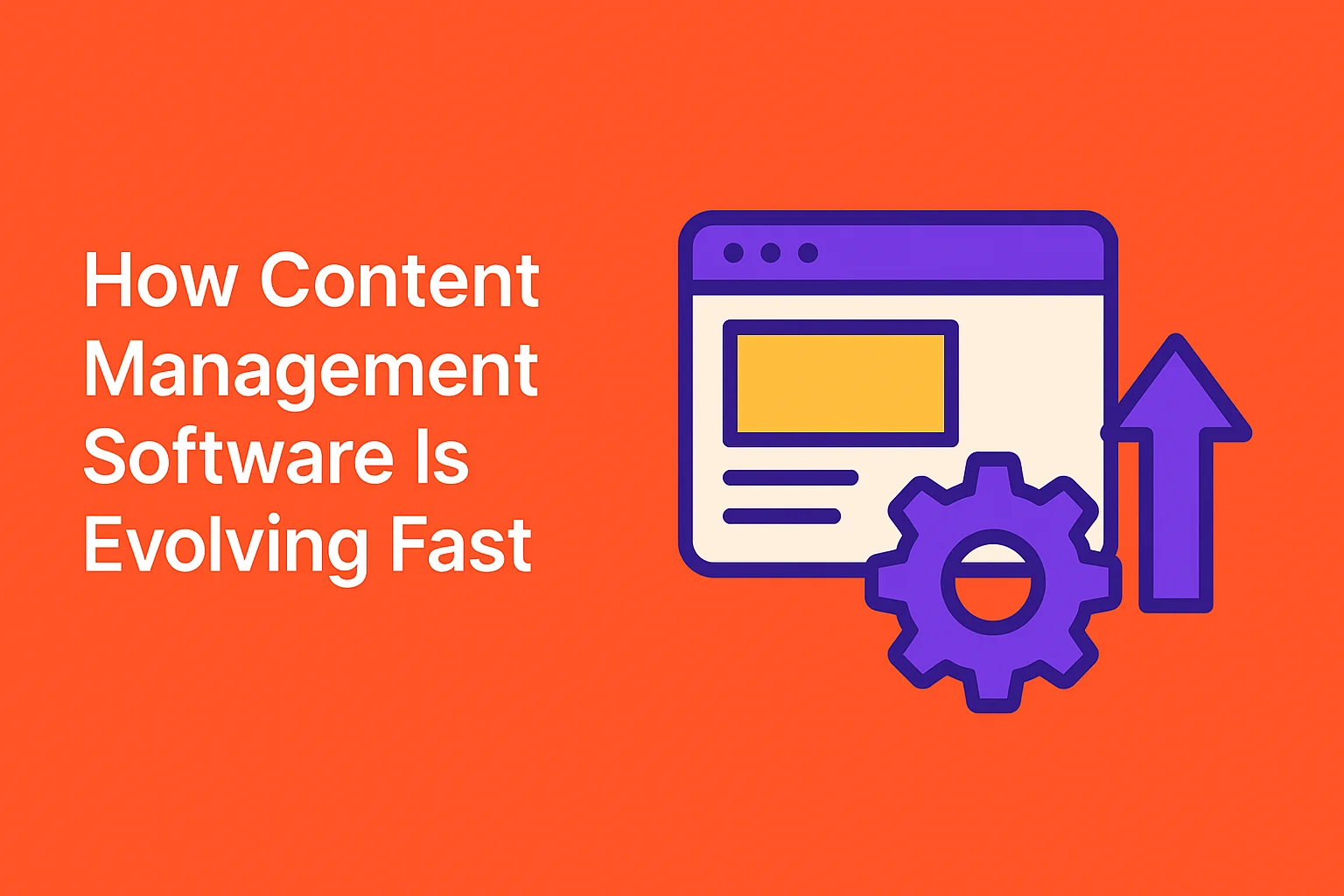Many organizations use content management software to handle websites, blogs, and digital storefronts. This type of platform has changed from static systems into more advanced, scalable models that adapt to evolving user expectations. Present-day solutions offer headless setups, mobile improvements, and tailoring to address different needs. With these modern methods, businesses aim to improve brand presence and provide consistent experiences.
How content management software has shifted in recent years
Content management software at first focused on basic website building. Developers used static systems that offered minimal freedom beyond text edits. Modern solutions now separate the back end from the front end, making it simpler to provide content across web, mobile, and IoT channels. Widespread adoption comes from enhanced performance, quicker publishing, and flexible design options. Trendsetters focus on experiences that handle different user segments and frequent content changes, showing a shift away from monolithic setups.
Growing move from traditional CMS to headless CMS solutions
Headless CMS models give teams the freedom to publish content anywhere through APIs. This approach eliminates the strict linkage between front end and back end, which opens up effective cross-channel delivery. Many use RESTful frameworks, which make up 70% of public APIs in the web sphere [Contentstack]. Recent success stories show lightning-fast updates, reduced developer reliance, and simpler management compared to older, monolithic systems. Users also report improved site performance with these options.
How mobile optimization changed CMS usability
Mobile-friendly designs changed content management by requiring swift load times and layouts that adapt to screens. Over the past decade, content management has seen improvements [Multicollab]. Platforms like WordPress introduced responsive themes that improve browsing and display on smartphones. As mobile use grew, many systems added device-preview features for better design accuracy. This emphasis on mobile readiness improved SEO, boosted user satisfaction, and ensured consistent branding across different digital channels. This trend is still ongoing.
Evolution of user experience design in CMS tools
User interfaces changed from fixed templates to responsive layouts that handle varied screen sizes. In 2010, Ethan Marcotte created the term ‘responsive design’ to create fluid and flexible site experiences [Contentstack]. This shift led to flexible browsing menus, clear typography, and accessible design patterns. Many CMS options now support tailoring, advanced media handling, and consistent layouts. These improvements help brands improve their online presence and reduce editing steps through easy-to-use design structures. This approach continues.
Choosing a content platform based on modern needs
Companies need solutions that match modern expectations around tailoring, security, and cross-platform delivery. Many organizations also evaluate workflow automation, integration options, and compliance features when choosing a content platform. Tools that simplify onboarding and support real-time edits help teams publish faster. A structured approach to governance reduces mistakes, which helps keep brand consistency. By comparing total cost of ownership, scalability, and support resources, businesses pick solutions that match current and future goals well.
Factors to weigh when choosing a content platform today
Organizations consider factors like ease of use, integration, and automation when choosing a content platform. Over 50% of organizations see automation of compliance and governance as highly important [LinkedIn]. Platforms that adapt to various formats, from text to video, support broader outreach. A detailed analysis of existing technology foundation helps find possible gaps. By checking vendor roadmaps, data security, and possible fast rollouts, teams pick a solution that fits multiple use cases. This method works.
Role of business size in CMS decision-making
Small ventures usually want an easy setup that reduces learning curves. Larger large companies often need advanced security frameworks and specialized support teams [Convergine]. Mid-range platforms sometimes have trouble with heavy traffic or complex content libraries. Decision-makers consider training requirements, ongoing management needs, and budget limits. A smaller business may value quick deployments, while bigger operations focus on scalability and strong integrations. Matching a platform’s features with growth plans helps guarantee a stable digital presence overall.
Why scalability now drives the CMS selection process
Scalability means handling growth without worsening user results [Progress]. Seasonal peaks show the need for platforms that expand resources quickly and keep performance. Many businesses use open-source or managed PaaS setups to control hosting and compliance changes. SaaS platforms may limit advanced adjustments, harming scale-up efforts. Future expansion often requires flexible data storage, multi-site options, and strong integration. By planning for bigger content demands, teams reduce migrations later. This approach safeguards growth.
Comparing scalable content management tools for businesses
Modern solutions range from simple cloud-based builders to enterprise systems with advanced teamwork and security. Some small business owners prefer user-friendly platforms, while tech teams might require more open structures. Comparing each system involves checking integration support, cost structure, and global delivery options. A carefully chosen solution meets a company’s goals without making complex deployments. Teams that pick a flexible foundation avoid replatforming headaches. Scalability is still important, no matter the organization’s size or plan.
Flexible CMS for small business vs. enterprise-level needs
Small businesses often pick simpler platforms that require less upfront investment. Enterprise-level needs usually include advanced security, tailoring, and integration features. Decision-makers must look at total cost of ownership, from licensing and hosting to maintenance and support [Optimizely]. A flexible system can adapt as teams grow, avoiding future rework. Some enterprise tools offer hybrid options that combine the ease of a traditional CMS with the freedom of a headless approach. This helps large organizations expand.
Popular cms platforms for developers and tech teams
Tech experts often look for open-source platforms that allow deeper customization. Options like Drupal or Joomla offer strong security and large plugin libraries. WordPress remains popular for its ease of use, though advanced developers watch out for performance slowdowns with heavy plugins. Some prefer headless setups for greater control over front-end frameworks. Others select integrated cloud hosts that simplify server management. Each approach suits different coding preferences, budget sizes, and project timelines. This continues.
Cost-effectiveness and integration support across CMS platforms
Modern CMS options vary in pricing, from free open-source versions to subscription-based enterprise suites. Teams must consider possible add-ons, plugin-based expansions, and integration costs. A low entry price can increase if advanced features require premium add-ons. Some platforms offer official marketplaces for convenient plugin setups, making sure of updates. Others integrate well with CRM systems or payment gateways for transactional functionality. Evaluating the balance between immediate savings and long-term performance affects final choices. This approach works.
Conclusion
Organizations now need flexible, secure, and scalable content management software that includes a range of use cases. Traditional methods still exist, but headless CMS approaches lead the pack by providing better speed and omnichannel publishing. Mobile improvements is still an ongoing priority, and user experience features continue to evolve with responsive layouts and tailoring. By considering factors like budget, security, integration, and expansion, businesses find platforms that suit their size and sector. Developers often prefer open-source models, while small teams look for easy deployment and minimal training. Enterprise-level players require strong governance processes and deeper support. Assessing the total cost of ownership, user access limits, and compliance needs helps with platform selection. The right content foundation can adapt to modern challenges and keep digital operations consistent, efficient, and ready for growth. This climate encourages innovation.
FAQs
Here are questions people frequently ask about finding and using the right content management software. Each answer addresses key points, such as platform selection strategies, headless CMS benefits, and scaling tips for different team sizes and technical requirements. These follow.
What should I prioritize when choosing a content platform?
Are headless CMS solutions better than traditional CMS in 2025?
What are the best CMS platforms for developers right now?
How do scalable content management tools benefit small brands?
Is a CMS for small business still efficient as teams grow?
How has content management software evolved for remote teams?

Ridam Khare is an SEO strategist with 7+ years of experience specializing in AI-driven content creation. He helps businesses scale high-quality blogs that rank, engage, and convert.



